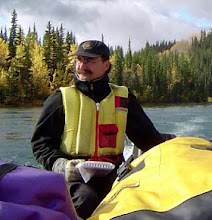 |
| The Takhini River throwing ice into the Yukon in late October. |
Gilbert White's introduction to his Natural History of Selborne (1789) describes the benefits of careful observation of the world about us. His letters provide a collection of lyrical epistles on the natural landscape of a
small corner of southern England. White, a product of the Enlightenment,
was sure much could be learned from nature through simple observation
and the application of human reason. He also sounds an 18th century clarion
call to fulfill a long time wish of mine; the examination of the freeze-up of the Yukon River.
"The Author of the following Letters takes the liberty, with all proper deference, of laying before the public his idea of parochial history, which he thinks, ought to consist of natural productions and occurrences as well as antiquities. He is also of the opinion that if stationary men would pay some attention to the districts on which they reside, and would publish their thoughts respecting the objects that surround them, from such materials might be drawn the most complete county histories.... If the writer should appear to have induced any of his readers to pay a more ready attention to the wonders of the Creation, too frequently overlooked as common occurrences; or if he should by any means, through his researches, have lent a helping hand towards the enlargement of the boundaries of historical and topographical knowledge... his purpose will be fully answered."
I have two copies of White's book. A lovely illustrated version of the letters published in 1993 which I like on the shelf but rarely look at and, my first copy, a soldier's edition published by Penguin in the early days of the Second World War. Clare Leighton's nostalgic wood engravings of the English countryside illustrate the book. The most striking image however is the front inside cover advertisement. Apparently the British Army was convinced that troops imbued with rational thought, cogent powers of observation and healthy teeth would be more than a match for the poor Germans burdened with Mein Kampf.
 |
| No doubt a trophy from Dunkirk. |
Having recently retired from full time work, that is, I am now a "stationary man," I felt I ought to approach my district and publish thoughts respecting the objects that surround me. Under White's guidance I spent two weeks observing the freeze-up of the Yukon River just north of Whitehorse. I purposefully did not talk to my hydrologist friend nor did I check the internet for background. I would join Gilbert in spirit and the two of us would wander the river bank to watch the water, rising and falling, flowing and foaming, and gradually stiffening into the ice which will stay until spring.
On October 29 I noted that both the Takhini and Yukon rivers were low. The wide banks showed a drop of a metre or more from summer high water, and the tempestuous rapids broke up the moving sheets of ice.
From my vantage point at the end of the Takhini River I saw rounded pans of ice. It appeared that larger sheets of ice, probably formed on Kusawa Lake upstream, entered the river. As the ice banged against other flows and the river banks the sheets were tinkered into round flan pans, with raised edges of crushed ice, which spun crazily in the current.
 |
| The Yukon River just below the Takhini confluence. |
The Yukon River is free of ice until the pans from the Takhini entered. Below the confluence the pans traced a river in a river as the cooler water of the Takhini swung back and forth across the Yukon River waters around it. Although the Yukon River also has a lake as its source the Whitehorse hydro electric dam both stops the ice and the friction of the water blasting through the turbines appears to raise the temperature to keep ice forming for some distance down river.
 |
| A floating mat of connected ice pans. |
A little further downstream the river curves north and a large back eddy collects ice pans too close to the edge of the current. These gradually coalesce into a knobbly ice sheet lightly attached to the small shelf of shore ice. The current line is clearly marked by the smooth edge of the sheet.
Getting close to the shore ice shows its very different pattern of crystallization. The ice is black, lacking the air which has been absorbed by the pans during their journey. And the ice crystals are clearly visible in three dimensions, imperfections on the ice surface acting as anchors for the condensation of the moist river air as it passes over the shore ice. These intricate and delicate, feather-like structures rise a centimetre into the air.
Nearby Little Takhini Creek, its water source up Heckel Hill, seen in the distance, now frozen, has dwindled to a slow trickle below a thin sheet of icy snow. And down by the Yukon River the stones from the fall's campfires are still visible and the water flows on unmindful of the winter to come.











I feel that I was a tiny part of this blog and that made me read it very carefully!
ReplyDelete